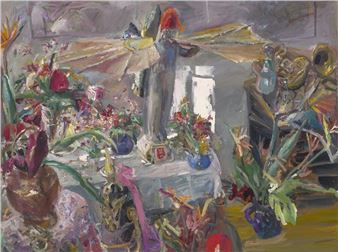Das groĂźe Tableau: The Big Picture
Knowledge is connected with the sense of sight: Anyone who has witnessed something can testify to it, that is, know it. Instruments of knowledge such as archives, collections, lists and encyclopedias arrange that which is confusing. Diagrams, maps and atlases provide an overview. Models and charts give shape to the abstract and the invisible. As in scientific treatises, conceptualization is at work here. They formulate, systematize, classify and discard. Despite all the striving for objectivity and universality, these patterns of order are not irrefutable: as the results of numerous assumptions and products of their historical and social conditions, they can even be controversial. Knowledge is not arbitrary, but changing, and there are numerous vantage points.
The surprisingly playful “Chronographic Map” has been handed down to us from the 18th century. Jacques Barbeu-Dubourg (1709-79) of France created a sensorial and pre-cinematic apparatus for the laborious study of a multitude of historical treatises. Using cranks, the then-accepted version of human history—which spanned 6500 years, beginning with Adam and Eve—could be viewed in one piece. The 16-meter-long timeline with sophisticated pictograms made it possible to identify historically parallel developments. For the art historian Astrid Schmidt-Burkhardt, this early learning machine is a remarkable feat of visual and interactive vision, of entertaining, even cheerful, scholarship.
Seeing and knowing, art and science have been connected since their beginnings and can mutually fertilize each other in interplay. Art offered room for visions and speculations to develop. Some of them even became reality. Art was always of its time or revolutionary, when it was able to capture current world knowledge in an image. Categories, images and methods of science are themselves always reflections of the current understanding of the world and, as such, objects of artistic inspiration and criticism.

Recommended for you
Knowledge is connected with the sense of sight: Anyone who has witnessed something can testify to it, that is, know it. Instruments of knowledge such as archives, collections, lists and encyclopedias arrange that which is confusing. Diagrams, maps and atlases provide an overview. Models and charts give shape to the abstract and the invisible. As in scientific treatises, conceptualization is at work here. They formulate, systematize, classify and discard. Despite all the striving for objectivity and universality, these patterns of order are not irrefutable: as the results of numerous assumptions and products of their historical and social conditions, they can even be controversial. Knowledge is not arbitrary, but changing, and there are numerous vantage points.
The surprisingly playful “Chronographic Map” has been handed down to us from the 18th century. Jacques Barbeu-Dubourg (1709-79) of France created a sensorial and pre-cinematic apparatus for the laborious study of a multitude of historical treatises. Using cranks, the then-accepted version of human history—which spanned 6500 years, beginning with Adam and Eve—could be viewed in one piece. The 16-meter-long timeline with sophisticated pictograms made it possible to identify historically parallel developments. For the art historian Astrid Schmidt-Burkhardt, this early learning machine is a remarkable feat of visual and interactive vision, of entertaining, even cheerful, scholarship.
Seeing and knowing, art and science have been connected since their beginnings and can mutually fertilize each other in interplay. Art offered room for visions and speculations to develop. Some of them even became reality. Art was always of its time or revolutionary, when it was able to capture current world knowledge in an image. Categories, images and methods of science are themselves always reflections of the current understanding of the world and, as such, objects of artistic inspiration and criticism.
Contact details
















